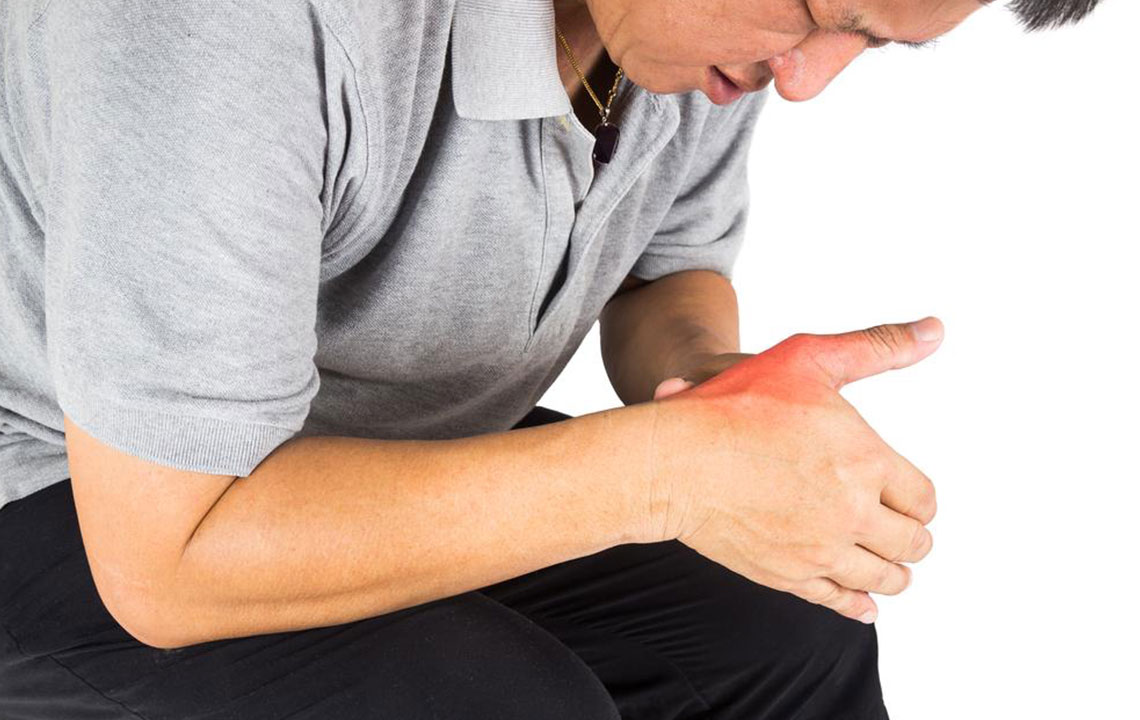Causes And Cure for Swollen Finger Pain

There can be many causes for swollen fingers, but when it occurs, it causes a lot of pain and discomfort. It becomes difficult to flex and move your fingers. Even simple tasks like picking up a pen, or writing becomes difficult. Swelling can occur due to injuries, allergies and also as symptoms of other diseases like arthritis. It can also be because of fluid retention. Blunt force injuries, injuries that cause a hematoma, a condition in which packets of blood accumulate outside the blood vessels after a finger trauma. Injuries can also occur if a thorn, a wood splitter or if other foreign objects penetrate your skin. Strains, fractures, sprains and other traumatic injuries on the hand, can also cause swollen fingers.
Other causes may include – Animal bites on the finger can cause wounds and swelling. Insect bites and stings can also trigger finger inflammation. Tight gloves, rings that have become a tight fit on your finger, and other such constrictions can interrupt blood flow and cause swelling. Paronychia and Cellulitis are infections that can occur in the region of the hands and fingers, and cause swelling and pain. Septic Arthritis is caused by bacterial infection in the joints. This can also affect finger joints.
Septic Bursitis can be another main cause. Bursae are small fluid-filled sacs near your joints. These cushion the muscles, tissues, and tendons and prevent friction in the joint regions. When there is inflammation of the bursae, it is called bursitis. Bursitis in your finger joints can be extremely painful. Lymphedema is a condition, where the Lymph fluid does not drain out of your body properly and starts collecting in places like your feet and hands. This can lead to the swelling of your hands and fingers.
Heat can cause blood vessels to expand, leading to inflammation, redness, and soreness in the fingers and hands. If it is too painful, you can try putting ice on it to cool down the area and reduce the swelling. Carpal Tunnel Syndrome is a condition that causes pain and swelling. The nerve that runs from the palm of your hand to the forearm, is squeezed or strained. This can be a very painful condition affecting not just fingers but causing pain throughout the affected hand.
Preeclampsia is a pregnancy-related condition, that can cause swelling in the face and hands. If you notice these symptoms during pregnancy, consult your doctor at once. If left untreated, preeclampsia can cause complications that can put the life of both the mother and unborn child at risk. Raynaud’s Disease is another condition that can result in swollen fingers. It is a disease that causes the arteries to become narrow, interrupts blood circulation, and so causes inflammation. It affects women more than men.
Water retention can also result in inflammation. Water retention can occur due to various reasons like kidney failure, too much salt intake, etc. This excess fluid collects in places like feet and hands, resulting in swelling and pain. Osteoarthritis and Rheumatoid Arthritis can also affect finger joints, causing inflammation, stiffness, and pain.
Simple Remedies for Swollen Finger Pain
You can try some simple measures to reduce the swelling in your fingers and hand.
- Keep the region elevated. Stack some pillows beside the hand and rest your hand on it.
- Try a simple hot and cold therapy—Fill two bowls, one with hot water and one with cold water. Immerse your hand first in the hot water bowl for a few minutes. Then, plunge your hand in the cold water bowl and rest it for a minute or two.
- Try some gentle hand exercises after the pain has reduced. This can help prevent more swelling and pain.
- Put ice on the swollen area to numb the area and reduce swelling. If the finger is injured and movement causes pain, you can tape it to the next finger to immobilize it.
- Try some warm oil massage. Lightly heat olive oil or mustard oil, and apply it over the swollen fingers. Then slowly massage the fingers from the tip and move down towards the wrist.
- If the swelling is due to infection, add some garlic, turmeric, and carom seeds to an oil like olive oil or mustard oil and use it for a warm oil massage. It gets rid of infection as well as inflammation.
- Black Tea contains tannins and antioxidants. They help get rid of inflammation and fluid retention. Make tea using black tea bags. Take out the used tea bags and squeeze out the water. Put the black tea bags in the refrigerator for some time. Take them out when they are cold and place them on the affected fingers. Hold the tea bags on the fingers for a few minutes.
- Epsom salt is another good remedy for swollen fingers. Magnesium sulfate present in this salt helps relax the muscles in your hand and reduces pain and swelling. Dissolve one or two tablespoons of Epsom salt in a large bowl of hot water. When the water has cooled down enough for your fingers to tolerate the heat, immerse your fingers in the bowl for 10 to 15 minutes.
- Turmeric is a proven antiseptic and antibiotic. It contains an active ingredient called curcumin that is an effective antiseptic, and also has antioxidant and anti-inflammatory properties. Mix a ½ teaspoon of turmeric powder in enough amount of olive oil, to make a smooth paste. Apply this to the affected fingers. Wait till it gets completely dry, then wash it off with warm water.
Do some regular finger and hand exercises to retain flexibility in your hands and improve blood circulation. Include a lot of fruits and vegetables in your diet, to keep the lymphatic system healthy.
Reduce salt in your diet to prevent fluid retention.


